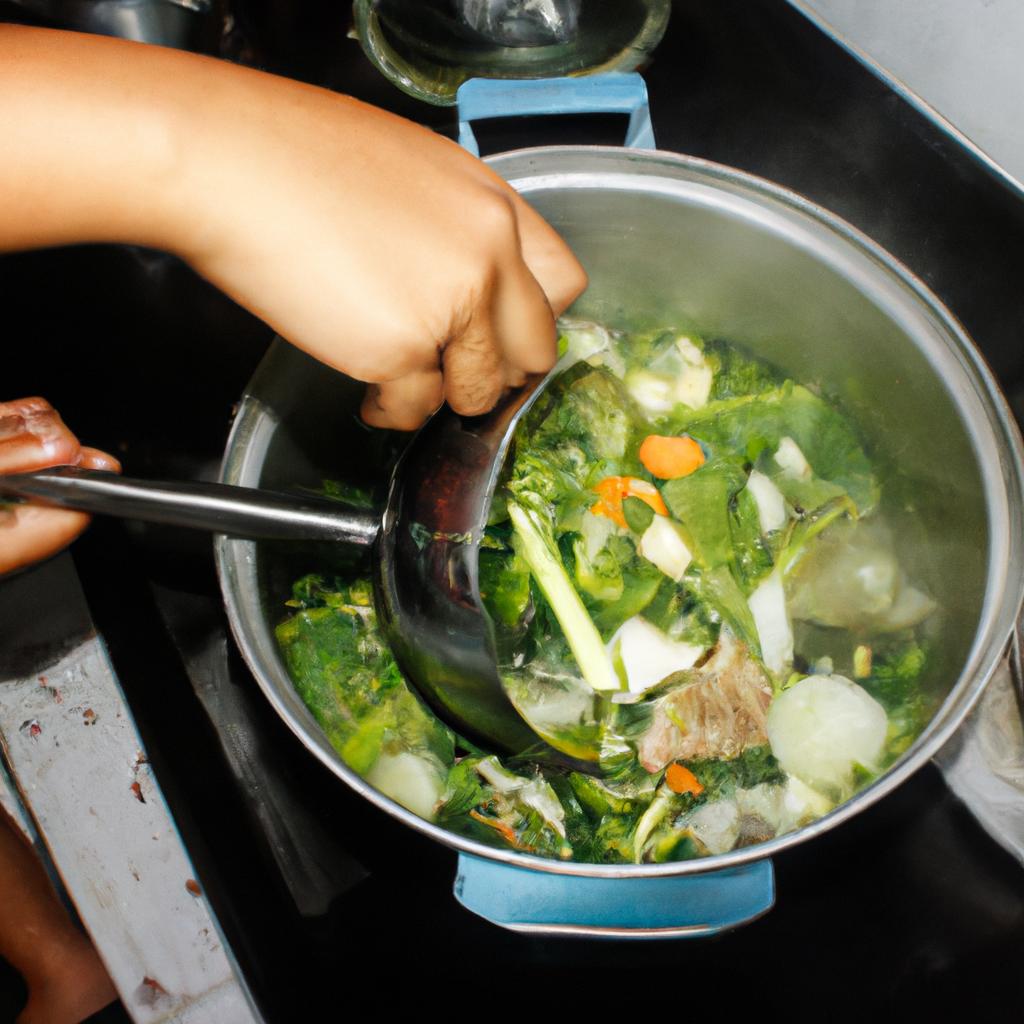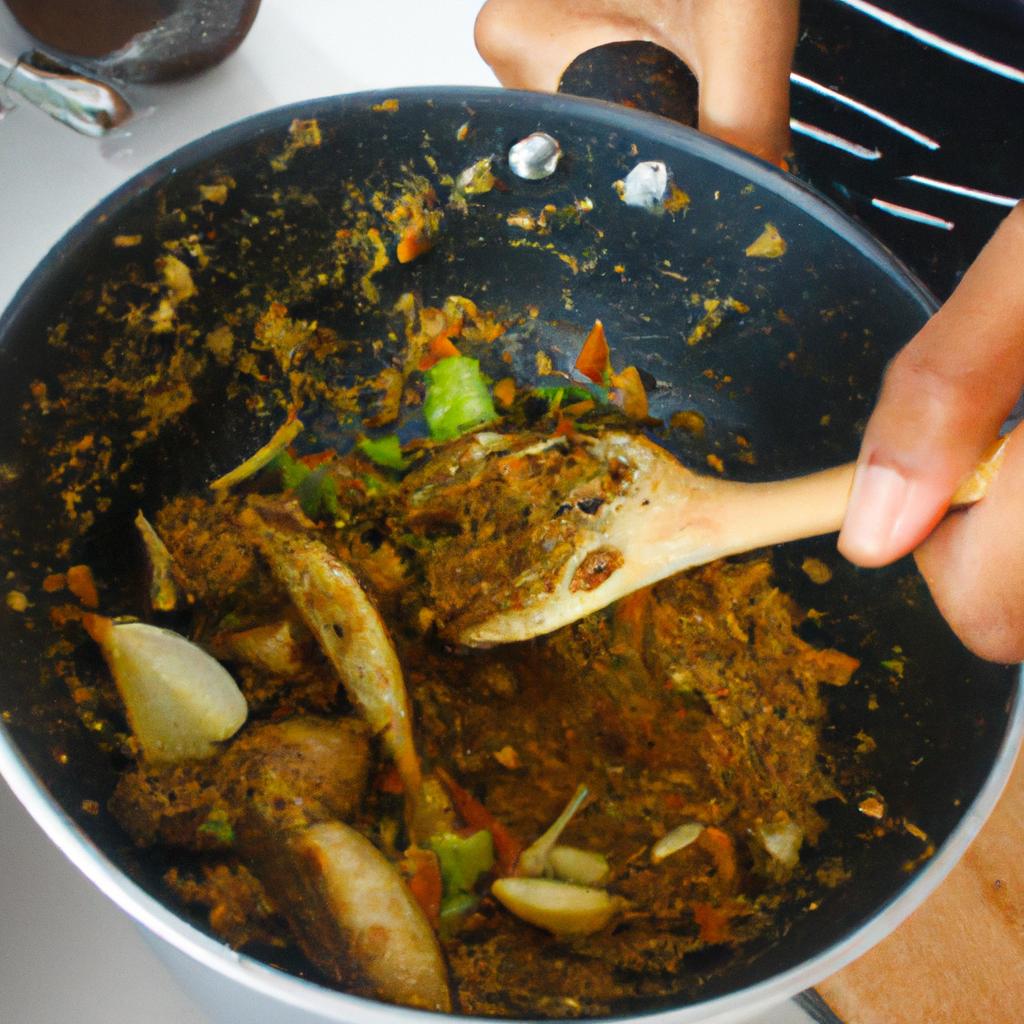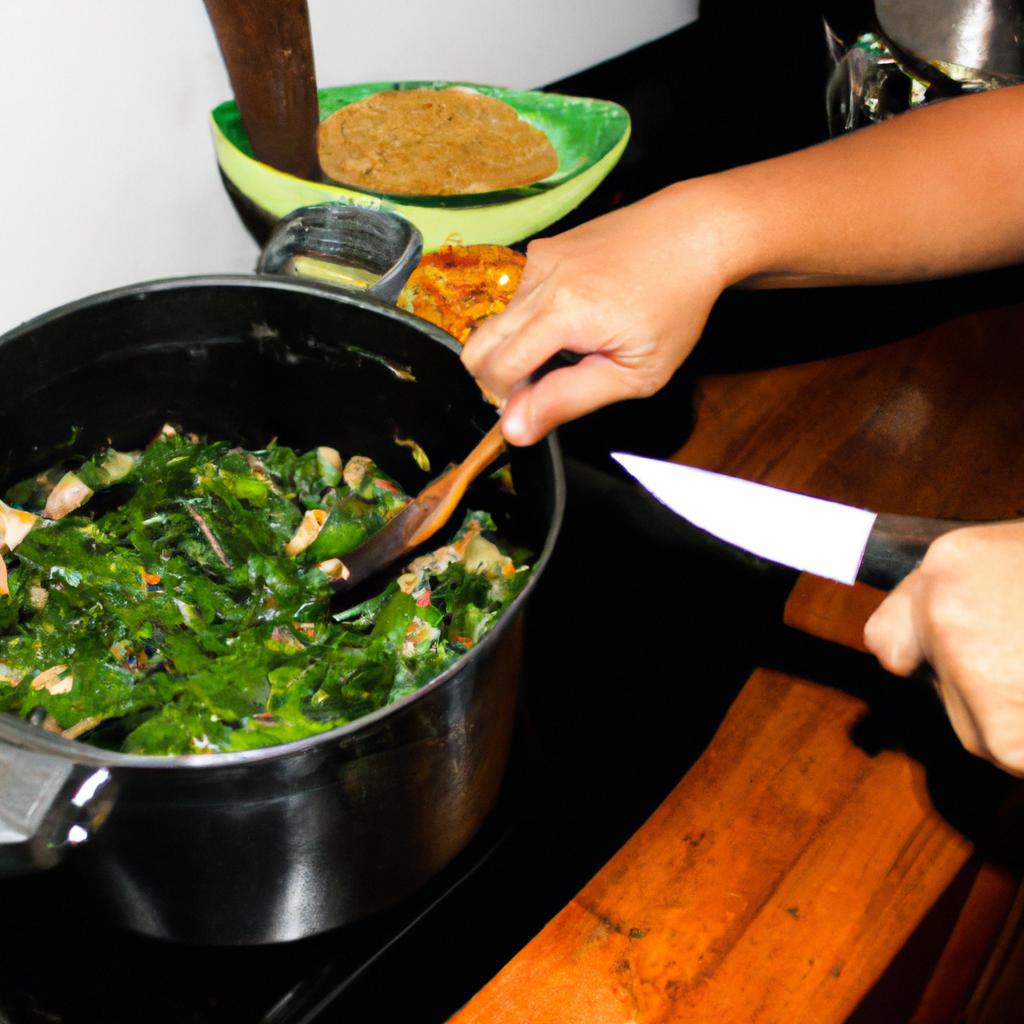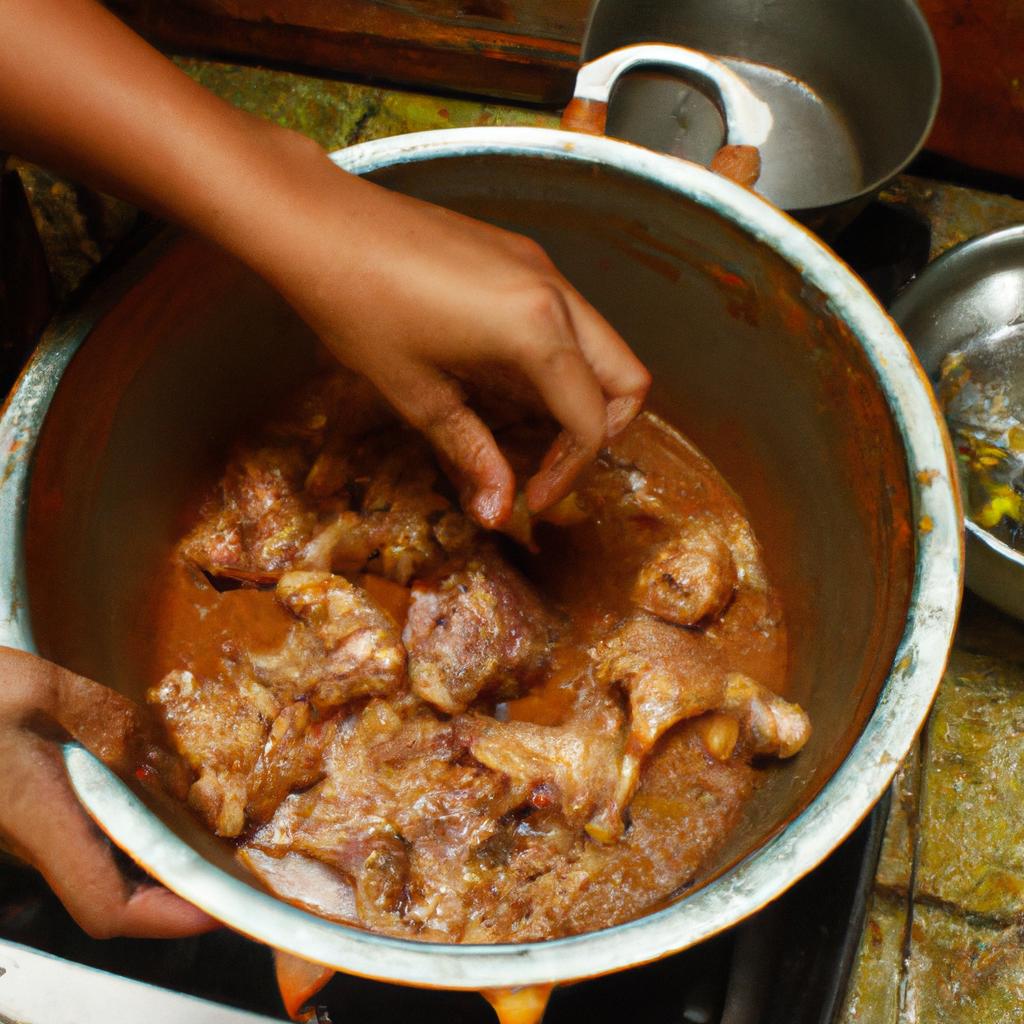Sinigang, a traditional Filipino dish, is a savory and tangy soup that has become a staple in many households across the Philippines. Often served with rice, sinigang offers a unique blend of flavors that tantalize the taste buds and leave one craving for more. This article explores the origins of sinigang, its diverse variations, and its significance within Filipino culture.
Imagine sitting at a bustling family gathering in the heart of Manila, surrounded by loved ones eagerly awaiting their meal. The aroma of simmering tamarind broth fills the air as you watch your grandmother skillfully prepare a steaming pot of sinigang. As she adds an assortment of vegetables and tender cuts of meat to the broth, each ingredient harmoniously combines to create a symphony of flavors – sourness from the tamarind, richness from the meat, and freshness from the vegetables. Sinigang embodies not only the artistry involved in creating this delectable delicacy but also represents the deep-rooted traditions passed down through generations.
Historically, sinigang was born out of necessity during periods when fresh ingredients were scarce or when preserving food became essential due to lack of refrigeration. By utilizing souring agents such as tamarind or other local fruits like kamias (bilimbi), guava, or unripe mangoes, Filipinos were able to prolong the shelf life of their meats and vegetables. These souring agents not only acted as natural preservatives but also imparted a distinct tangy flavor to the dish.
While sinigang traditionally used pork as its main protein, over time, variations of sinigang have emerged using other types of meat such as beef, chicken, fish, or shrimp. Each variation brings its own unique twist to the dish, with different cuts of meat adding their own flavors and textures.
Sinigang is typically prepared by simmering the meat in a broth made from the souring agent and water. The vegetables are then added at various stages of cooking to ensure that they remain crisp and retain their vibrant colors. Common vegetables found in sinigang include kangkong (water spinach), sitaw (long beans), talbos ng kamote (sweet potato tops), gabi (taro root), and okra.
The balance of flavors in sinigang is crucial. The tartness from the souring agent should be well-balanced with the richness of the meat and the freshness of the vegetables. Some prefer their sinigang to be more on the tangy side, while others enjoy a milder version. Either way, this versatile dish can be adjusted according to one’s personal preference.
Sinigang not only satisfies hunger but also holds cultural significance for Filipinos. It represents unity and bonding among family members as it is often served during gatherings and special occasions. The act of sharing a comforting bowl of sinigang strengthens familial ties and rekindles fond memories.
In conclusion, sinigang is more than just a soup; it is a symbol of Filipino heritage and culinary artistry. Its origins rooted in resourcefulness have evolved into an iconic dish that continues to bring people together. Whether enjoyed with loved ones in the bustling streets of Manila or recreated in kitchens worldwide, sinigang remains a beloved and timeless Filipino delicacy.
Ingredients for Sinigang
One popular Filipino dish that is often served with rice is sinigang. This savory and tangy soup is a staple in Filipino cuisine, loved by locals and foreigners alike. To prepare this delectable delicacy, several key ingredients are required.
The first essential component of sinigang is the protein source. Common choices include pork, beef, shrimp, or fish. The selection of protein can greatly influence the overall flavor profile of the dish. For instance, using pork ribs adds richness and depth to the broth, while shrimp provides a distinct sweetness. Additionally, some variations of sinigang incorporate other types of meat such as chicken or even goat.
Next on the list are an assortment of vegetables that give sinigang its vibrant colors and fresh taste. Traditionally, tamarind is used as the souring agent for this soup. However, other fruits like guava, calamansi (Philippine lime), or kamias (bilimbi) can also be utilized depending on regional preferences. Alongside these souring agents, various leafy greens such as kangkong (water spinach), mustard leaves, or bok choy contribute their unique flavors and textures to complement the main ingredients.
To enhance the flavor further, it’s common to add additional seasonings and spices to the broth. These may include onions, garlic cloves, tomatoes for acidity and umami notes; ginger or lemongrass for a refreshing kick; and long green chili peppers known as “siling pansigang” to provide heat when desired.
Incorporating these diverse ingredients not only creates a harmonious blend of flavors but also offers numerous health benefits due to their nutritional content. Sinigang is packed with vitamins from vegetables like vitamin C from tamarind or guava and iron-rich leafy greens like kangkong.
By combining all these elements together in one pot, sinigang becomes a hearty and nourishing meal that satisfies both the palate and the body. It’s no wonder why this Filipino delicacy has gained popularity worldwide.
Moving forward, let us explore the different varieties of sinigang and how they differ in taste and preparation methods.
Different Varieties of Sinigang
Transitioning from the previous section, where we explored the essential ingredients used in sinigang, let us now delve into the different varieties of this beloved Filipino dish. To illustrate its versatility, consider a hypothetical scenario wherein a family gathers for a special occasion and decides to prepare sinigang using various proteins such as pork, shrimp, salmon, and chicken. This diverse selection highlights how sinigang can be adapted to suit individual preferences while still retaining its distinct flavors.
To evoke an emotional response and provide further insight into the variations of sinigang, here are four key characteristics that differentiate each variety:
- Protein Base: Sinigang can feature various proteins like pork (the most common), beef, fish, shrimp/prawns, or even chicken.
- Sourness Level: The sourness of sinigang is derived from tamarind pulp or other souring agents like guava or kamias. Depending on personal taste preferences, some individuals might prefer a more tangy broth while others may opt for a milder flavor profile.
- Vegetable Selection: While traditional vegetables include kangkong (water spinach), string beans, radish, and eggplant; modern interpretations have introduced additional options such as baby corn, okra, tomatoes, and taro roots.
- Additional Flavorings: Apart from the core ingredients mentioned earlier, sinigang can also incorporate aromatic spices like onions and garlic to enhance its overall taste.
To present these differences in an organized manner:
| Variety | Protein Base | Sourness Level | Vegetable Selection |
|---|---|---|---|
| Pork Sinigang | Pork | Tangy | Kangkong (Water Spinach), String Beans, Radish, Eggplant |
| Shrimp Sinigang | Shrimp | Mild | Kangkong (Water Spinach), Tomatoes, Okra |
| Salmon Sinigang | Salmon | Tangy | Kangkong (Water Spinach), Baby Corn, Taro Roots |
| Chicken Sinigang | Chicken | Milder | Kangkong (Water Spinach), String Beans, Tomato |
In exploring the diverse varieties of sinigang and their unique characteristics, it becomes evident that this dish offers an array of options to cater to different tastes and dietary preferences. From tangy pork sinigang with traditional vegetables to milder chicken sinigang with a varied selection of ingredients, each variety provides a distinct culinary experience.
Transitioning into the subsequent section on Traditional Cooking Methods, one popular technique for preparing sinigang involves employing specific steps rooted in Filipino tradition. By following these methods closely, individuals can ensure an authentic and flavorful dining experience without compromising on cultural heritage.
Traditional Cooking Methods
The diversity of Filipino cuisine is evident in the various regional interpretations of sinigang. From the bustling streets of Manila to the coastal towns of Visayas, this delectable dish can be found with unique flavors and ingredients that reflect the local culture and traditions. To illustrate this point, let us delve into a hypothetical case study featuring two different regions – Luzon and Mindanao.
In Luzon, specifically in Metro Manila, sinigang is commonly prepared using pork as its main protein source. The tangy broth is achieved by simmering tamarind pulp or other sour fruits like guava or kamias with an assortment of vegetables such as kangkong (water spinach), okra, radish, and eggplant. This combination creates a flavorful harmony between the sweet-sour taste of the soup and the rich umami flavor imparted by the tender pork cuts.
On the other hand, in Mindanao’s Davao City, sinigang takes on a distinct twist. Here, locals use fish as their preferred protein base instead of pork. Known for its abundant marine resources, Davao City boasts an array of seafood options that add depth to their sinigang. Fish varieties like bangus (milkfish) or lapu-lapu (grouper) are often used alongside indigenous vegetables like gabi leaves (taro leaves) and sigarilyas (winged beans). The resulting sinigang embodies the freshness of coastal living combined with vibrant local produce.
This remarkable variety across different regions showcases how sinigang adapts itself to suit local preferences while staying true to its core essence. It serves as a testament to both cultural diversity and culinary creativity within Filipino cuisine.
Now let us explore some key qualities that make sinigang so beloved among Filipinos:
- Comfort Food: Sinigang has become synonymous with warmth and comfort, evoking a sense of nostalgia for many Filipinos. Its hearty broth, coupled with the familiar taste of home-cooked meals, provides solace during challenging times.
- Versatility: This dish offers flexibility in terms of ingredient choices. Whether it be fish, pork, beef, or shrimp, sinigang accommodates various proteins without compromising its distinct flavor profile.
- Nutritional Value: Sinigang is packed with essential nutrients from the assortment of vegetables used in its preparation. It serves as a wholesome meal that fuels both body and mind.
- Social Bonding: Sharing a steaming pot of sinigang with family and friends fosters social connections and strengthens communal ties. It has become a centerpiece at gatherings and celebrations, creating cherished memories.
| Qualities | Description |
|---|---|
| Comfort Food | Evokes feelings of warmth and nostalgia |
| Versatility | Accommodates different protein choices while maintaining distinctive flavors |
| Nutritional Value | Packed with essential nutrients from diverse vegetables |
| Social Bonding | Fosters connections among family and friends |
As we delve deeper into the world of sinigang, let us now explore its traditional cooking methods – techniques passed down through generations that contribute to the dish’s remarkable taste and appeal.
In our subsequent section on “Health Benefits of Sinigang,” we will further appreciate this beloved Filipino delicacy by exploring its positive impact on well-being rather than focusing solely on culinary aspects.
Health Benefits of Sinigang
Traditional Cooking Methods
Sinigang, a Filipino delicacy known for its sour and savory taste, is often served with rice. The traditional cooking methods used to prepare sinigang contribute greatly to the distinct flavor profile of this popular dish.
One example of a traditional cooking method for sinigang involves boiling the main ingredients, such as pork or shrimp, in water along with tamarind pulp or other souring agents. This process allows the flavors to meld together while extracting the tangy essence from the souring agent. The resulting broth serves as the base for sinigang and provides its signature sour taste.
To enhance the complexity of flavors, various vegetables like kangkong (water spinach), radish, tomatoes, okra, and eggplant are added to the simmering pot of sinigang. These vegetables not only provide additional textures but also absorb some of the flavorful broth during cooking. As a result, they become tender yet still retain their vibrant colors and natural sweetness.
The use of slow-cooking techniques is another characteristic feature of traditional sinigang preparation. Simmering sinigang over low heat for an extended period allows all the ingredients to fully infuse their flavors into the broth. This slow-cooking method ensures that every spoonful bursts with rich umami notes balanced by a pleasant tanginess.
Emotional response bullet point list:
- Nostalgia-inducing aroma wafting through homes
- Comfort food that brings families together around the table
- Sense of pride in preserving cultural heritage through culinary traditions
- Glimpses into Filipino culture and history through food
| Traditional Cooking Methods | Emotions Evoked |
|---|---|
| Slow simmering | Cozy comfort |
| Use of local ingredients | Cultural pride |
| Tangy-savory flavors | Satisfying |
| Harmonious blending | Culinary delight |
As sinigang continues to be cherished and enjoyed by Filipinos, it is essential to understand the traditional cooking methods that give this dish its unique character. The combination of simmering ingredients with souring agents, complemented by an array of vegetables, results in a flavorful broth that encapsulates the essence of Filipino cuisine.
Transitioning into the subsequent section about popular side dishes to serve with sinigang, we will explore how these accompaniments further enhance the overall dining experience.
Popular Side Dishes to Serve with Sinigang
Exploring Popular Side Dishes
After understanding the health benefits of sinigang, it is essential to explore the popular side dishes that complement this delectable Filipino delicacy. One such example is pairing sinigang with a plate of steamed jasmine rice, which not only adds texture but also helps balance out the tangy flavors of the soup.
To create an even more satisfying dining experience, consider incorporating these four delightful side dishes:
- Crispy Fried Garlic: Sprinkling crispy fried garlic on top of your bowl of sinigang can provide an extra burst of flavor and aroma. The crunchiness greatly enhances each spoonful, making every bite irresistible.
- Patis: Also known as fish sauce, patis is a staple condiment in Filipino cuisine. Adding a few drops to your sinigang brings out its savory notes and elevates the overall taste profile.
- Bagoong: This fermented shrimp paste offers a unique umami flavor that beautifully complements the sourness of sinigang. It’s commonly used as a dipping sauce for vegetables or served alongside grilled meats.
- Sawsawan: Sawsawan refers to various types of dipping sauces typically served on the side. For sinigang lovers, combining soy sauce, calamansi juice (a local citrus fruit), and chopped chili peppers creates a zesty concoction ideal for adding an extra kick to every mouthful.
Moreover, let us delve into further details about these enticing accompaniments through the following table:
| Side Dish | Description | Best Complement |
|---|---|---|
| Crispy Fried Garlic | Adds crunchiness and aromatic flavor to the sinigang soup | Traditional pork or beef sinigang |
| Patis (Fish Sauce) | Enhances the savory notes of the soup with its umami taste | Seafood sinigang variants |
| Bagoong (Shrimp Paste) | Provides a unique tangy and salty kick that pairs well with sour flavors in sinigang | Vegetable-based sinigang options |
| Sawsawan (Dipping Sauces) | Offers a zesty condiment suitable for adding an extra layer of taste to every spoonful | Chicken or fish sinigang variations |
By incorporating these side dishes into your sinigang dining experience, you can elevate the overall enjoyment of this Filipino delicacy. The contrasting textures, flavors, and aromas create a harmonious symphony on your palate.
Transitioning into the subsequent section about “Sinigang: A Staple in Filipino Cuisine,” let us further explore why this dish holds such significance within Philippine culinary traditions.
Sinigang: A Staple in Filipino Cuisine
Transitioning smoothly from the previous section, where we explored popular side dishes that complement sinigang, we now delve into its significance as a staple in Filipino cuisine. To illustrate this further, let us consider the case of a hypothetical family living in Manila who prepare sinigang regularly.
In this scenario, the Garcia family gathers around their dining table on a Sunday afternoon. The aroma of simmering tamarind broth fills the air as they eagerly anticipate indulging in their favorite dish – sinigang na baboy (pork sour soup). As they sit down to eat, each member has their own preferred way of enjoying it. Some like pairing it with steamed white rice or garlic fried rice, while others prefer dipping crispy fish chips into the flavorful broth.
The popularity and cultural significance of sinigang extend beyond individual preferences and reach every corner of Philippine culture. Here are some reasons why sinigang holds such importance:
- It represents Filipino hospitality: In traditional Filipino households, serving guests with sinigang is an expression of warm hospitality. Its tangy flavor and aromatic ingredients create an inviting atmosphere during gatherings.
- It showcases local produce: Sinigang highlights various indigenous vegetables commonly found in the Philippines, such as kangkong (water spinach), gabi (taro root), labanos (radish), and talong (eggplant). These ingredients not only add color and texture but also promote sustainable cooking practices by utilizing locally sourced produce.
- It reflects historical influences: With Spanish colonization influencing Philippine culinary traditions, sinigang embodies the blending of cultures. The use of tamarind for souring agents demonstrates how Southeast Asian flavors were incorporated into native recipes.
- It fosters family connections: Sinigang is often prepared in large quantities, encouraging shared meals and bonding among family members. The act of preparing sinigang together creates opportunities for intergenerational knowledge transfer, as older generations pass down their unique family recipes to younger ones.
To further illustrate the cultural significance of sinigang, here’s a table showcasing some commonly used ingredients in this beloved Filipino delicacy:
| Ingredient | Flavor Profile | Nutritional Benefits |
|---|---|---|
| Tamarind | Tangy | High in Vitamin C |
| Kangkong | Earthy | Rich in Iron |
| Gabi | Starchy | Good source of Fiber |
| Labanos | Crisp and Mild | Packed with Vitamins |
| Talong | Slightly Bitter | High in Antioxidants |
As we can see, sinigang not only tantalizes taste buds but also nourishes the body with its nutritious ingredients. Its presence at Filipino dining tables symbolizes unity, tradition, and appreciation for locally sourced flavors.
In conclusion, sinigang holds an essential place within Filipino cuisine due to its ability to bring people together while celebrating local produce and culinary heritage. Whether it’s a special occasion or a simple Sunday gathering, sinigang remains a flavorful reminder of the rich culture ingrained in every Filipino meal experience.









